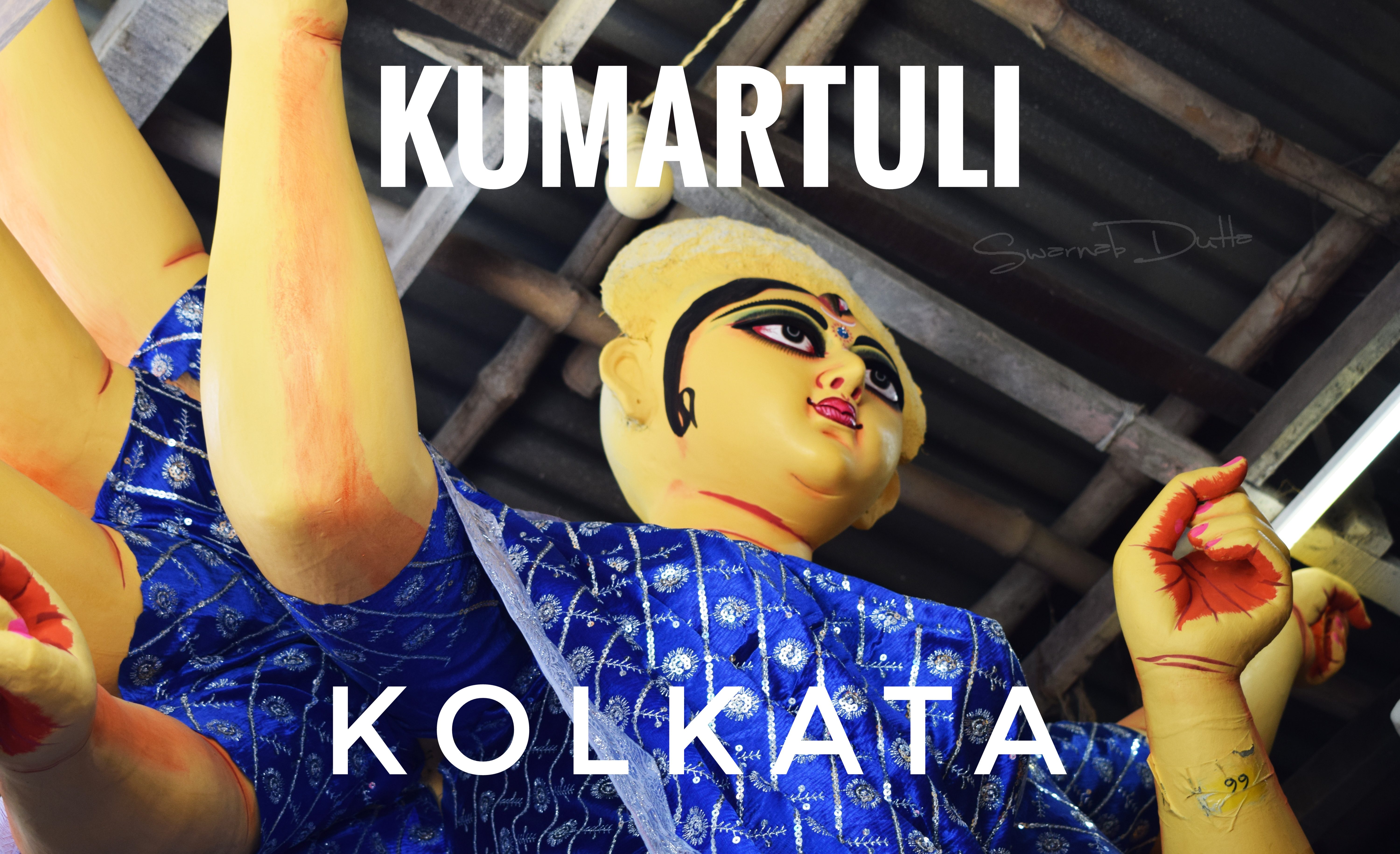We all love pandal hopping during Durga Puja. After all, it is a time of joy and celebration for Bengalis, who flock to the pandals with friends and families to admire the beautiful idols of Goddess Durga and her children. But have you ever wondered how the majestic idols that you see in Puja pandals are created?
ADVERTISEMENT
I finally got the chance to visit Kumartuli, the place where the magic happens. Well, I was planning to go to this place for the last three years but my plans got canceled for some reason or the other. But this year I somehow managed to explore the place and get a glimpse of the process of idol-making.
Kumartuli is a locality in Kolkata, where hundreds of artisans work tirelessly to craft the clay idols of Maa Durga and other deities. You can witness the whole process here, from the bamboo framework to the final painting and decoration.
In this article, you will get to know the following points about Kumartuli and my visit there,
Let’s see each of these points in detail.
Location of Kumartuli
| Address | Hatkhola, Kolkata, West Bengal – 700005 |
| Nearest Metro Station | Shobhabazar-Sutanuti |
| Nearest Train Station | Sovabazar Ahiritola |
The place is within walking distance of Sovabazar Metro Station. Use Google Maps or ask the locals for directions.
ADVERTISEMENT
It was a Sunday morning. I and a friend of mine hopped into the metro all set to explore this place. We got down at Sovabazar Metro station. Google Maps is your best guide while visiting places you have never been to.
We set the location on Google Maps and after a 7 min walk reached Banamali Sarkar Street. This is the main street where Kumartuli is situated.
Timings of Kumartuli
There are no specific timings for Kumartuli. It is open all throughout the day.
I would recommend you visit it in the early morning hours. We reached there around 9 AM.
Best time to visit Kumartuli
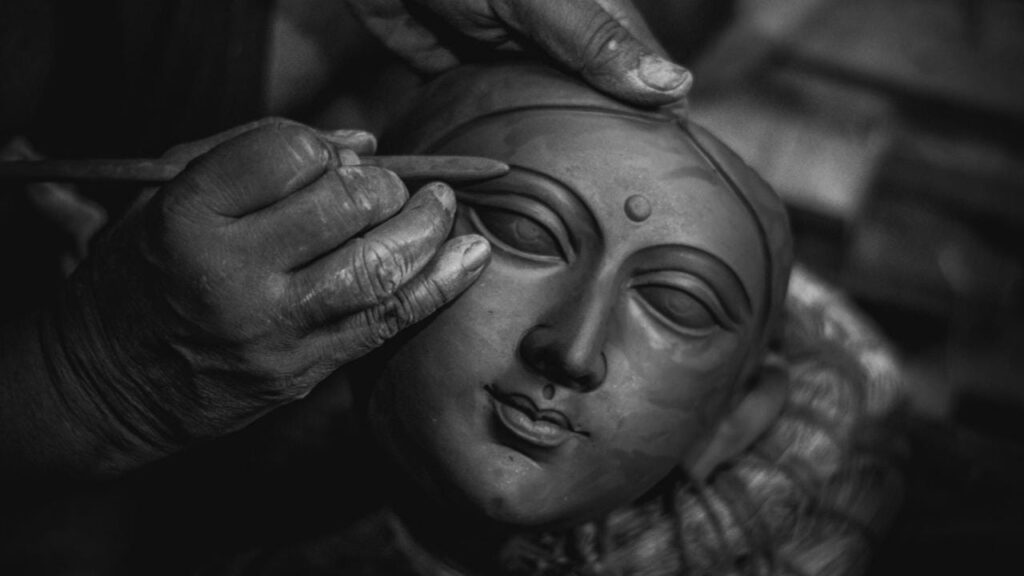
The best time to visit Kumartuli is about a month before Durga Puja.
During this time you will often see photographers wandering in these lanes trying to get their best shot. I also took out my camera and joined in. Even in the month of September, the weather was extremely hot. But nothing can stop me from exploring new places.
ADVERTISEMENT
You can also visit this place before any specific puja and see the idols of those gods and goddesses.
As we entered the lanes of KUMARTULI, we noticed workshops on both sides of the lanes with busy craftsmen working hard to make thousands of idols of different sizes. My interest in knowing more about Kumortuli was at its peak. Excitement was at its zenith!
History of Kumartuli Kolkata
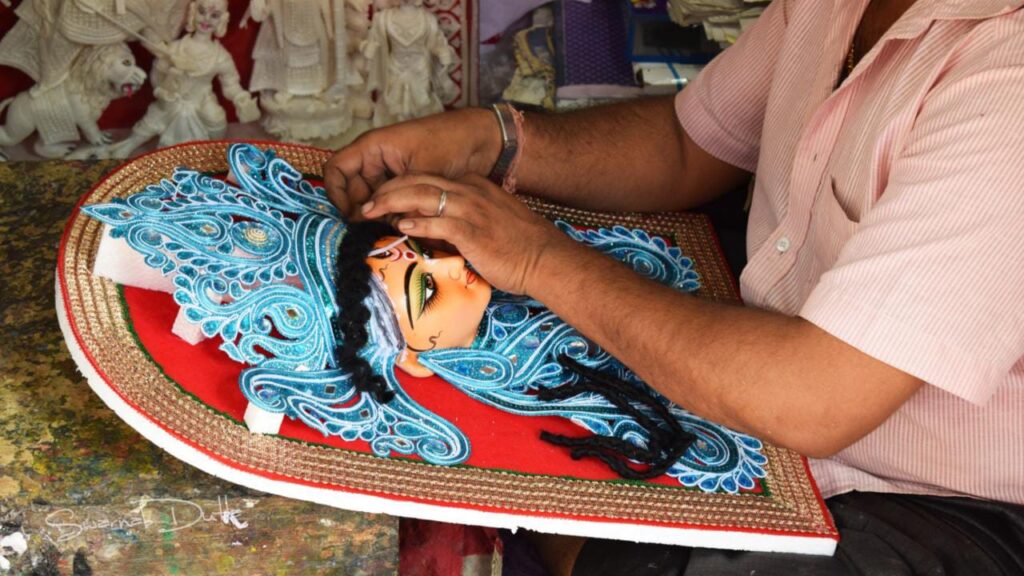
The name Kumartuli stands for “Potter Locality” and the locality is over 300 years old. It was formed by a bunch of potters who came there in search of a better livelihood. Now about 200 families live there, earning a living by sculpting idols for various occasions.
While my friend was busy clicking pictures, I asked one of the idol makers about the history of Goddess Durga’s idols in Kumortuli. With mud-laden hands, he replied that his forefathers started to make Durga idols about 175 years ago. He was quite surprised and happy to see me. And he confessed that he felt happy that “someone was interested to know about their history, community, and work”. And then he continued…
The demand for Durga Pratimas rose highly during the rule of the East India Company. The top idol makers were from Nadia. They built Durga idols following two styles “Kangshanarayani and Buishnupuri”.
ADVERTISEMENT
The styles had a common platform on which goddess Durga and her family were built in the same line with different sizes and heights. The decorated background Chalas of these idols were Kailashi Chala, Brindavani Chala, Indrani Chala, and Brahmani Chala.
I was quite engrossed in the story narrated by Pal Kumor.
He also told us about the renowned stalwarts and idol makers like Jatindranath Pal and Niranjan Pal and their masterpieces that were adopted by the Bonedi bari pujas of affluent zamindars like Sabarna Roy Choudhury, Debs of Sovabazar, Maitras of Darjipara and Dutta’s of Hatkhola.
I realized that these potters are very creative. They assembled the idols on one platform known as “Ekchala”. I understood the concept of Ekchala or a single platform form of Durga Pratima.
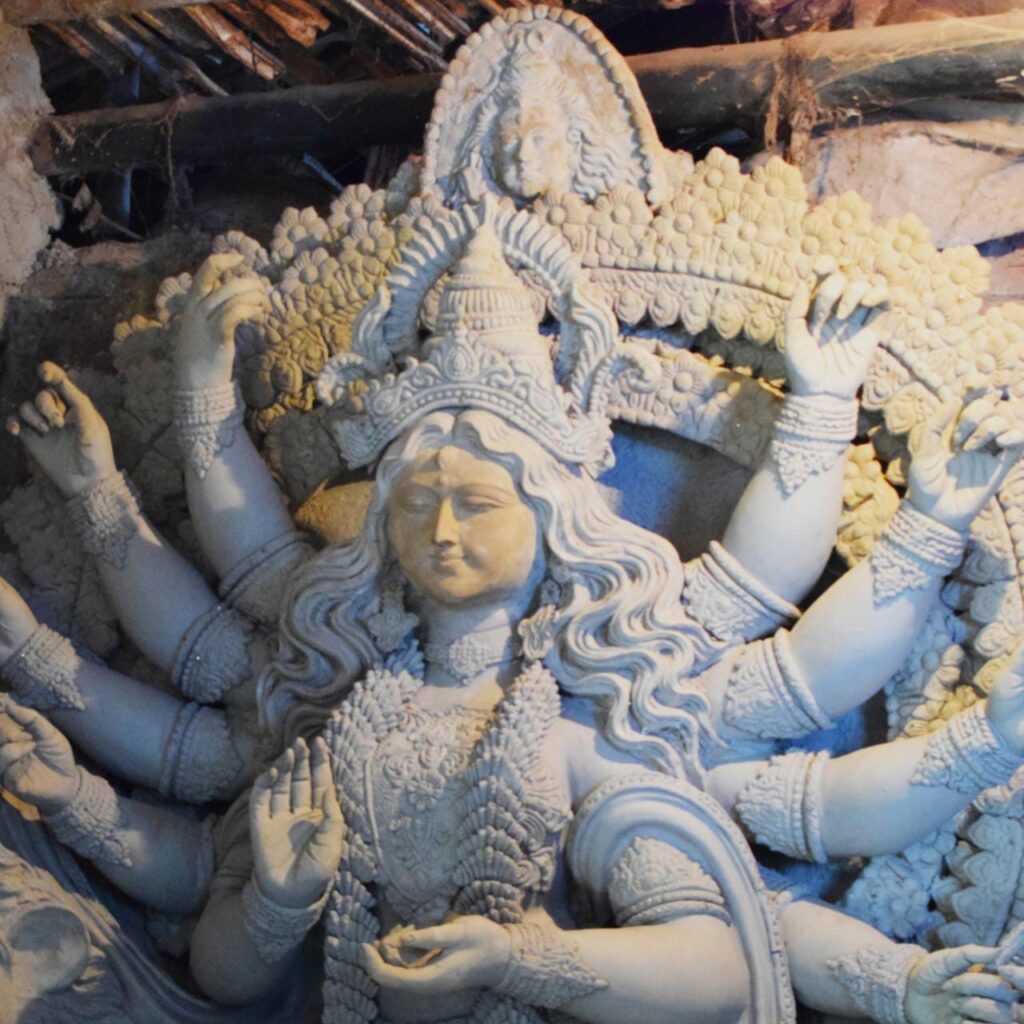
While we were having the conversation, one of the artisans hearing us said that the old school deity has a traditional and charming look of Devi Durga with bright yellow colored skin and bloodshot eyes. He added, “Tana Tana Chokh Jeno Matrishoktir Adhar”(the broad long eyes are the symbol of power and strength of women). Devi Durga and Lakshmi were generally painted yellow, Saraswati in white, and the Mahisashura in green.
Near where I was standing, there was an idol of a horse (also resembling a half-dragon). I pointed at it and asked out of curiosity “Horse is the consort of which deity”? A small child there giggled and replied, it is not a horse nor a dragon, it is the lion and the consort of Devi Durga.
ADVERTISEMENT
I was quite shocked. Pal babu replied the Rajbaris try to restore the old-world charm, and vintage beauty of the Durga pujas with yellow-colored idols, green asura, and a dragon-like lion. He added, “Try to visit Bagbazar Sarbojonin idol to see this old-school diety, one of the signature idols in Bengal as well”.
While filling colors on Lord Ganesha, he said, There has been a revolutionary change in the design of Ekchala Murti. Now Panchala (five separate platforms instead of one) is considered the new way of sculpting idols. The idol made now is made more human-like instead of a fearful image. The human-like figure of Devi Durga wins the hearts of devotees, although this transition was quite challenging for the potters.
The story of the traditional and contemporary style of making idols of Durga Devi really touched my heart.
Idols and other things to see in Kumartuli
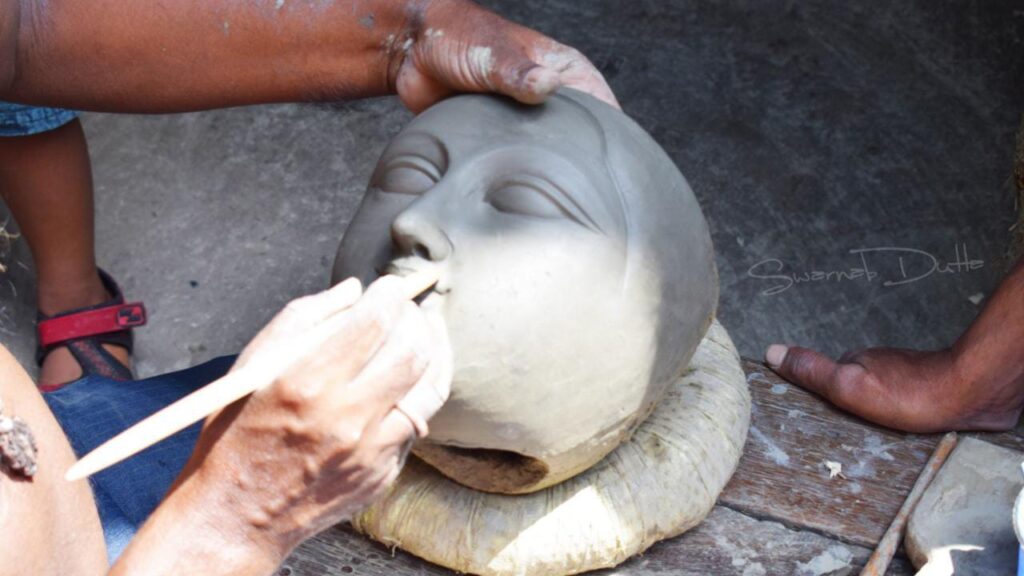
While I was there, some of the idols looked similar, while others were completely unique and theme-based.
During this Puja season, craftsmen from different parts of India come to work in these workshops. Idols from Kumartuli are also sent to other parts of India and also abroad.
ADVERTISEMENT
The idols are completely made in an environment-friendly way so that after Puja during the immersion of the idols, the water doesn’t get polluted. While we were exploring the place we came across a small press conference where the craftsmen of Kumartuli were explaining that they would even be using eco-friendly paint to paint the idols. It’s a wonderful step towards reducing water pollution to a great extent.
It was almost afternoon, and we had to return, so with many unheard stories and histories, we made our way back home. I really loved the lovely community of Kumortuli and will always appreciate the fine and flawless work of the Kumors.
If you love exploring new places, do visit this place and experience the feel of something so beautiful and vintage.
Other places to explore in Kolkata
- 5 Interesting Things To Do In Kolkata During Christmas
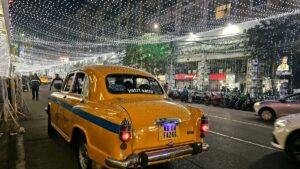
- ISKCON Radha Govinda Temple (Kolkata) – Timings, Address
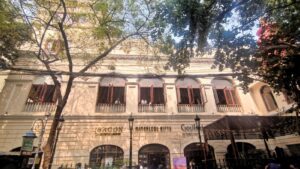
- 8 Best Places For A Day Tour From Kolkata (Within 150 Km)
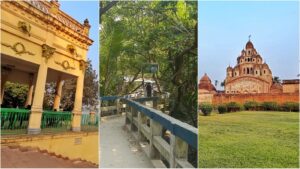
- 6 Most Beautiful Ghats In Kolkata That You Must Visit
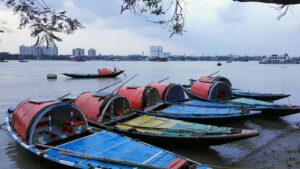
- 6 Famous Picnic Spots Near Kolkata Perfect For A Day Out

- Eden Gardens Park (Kolkata) – Timings, Entry Fee, History
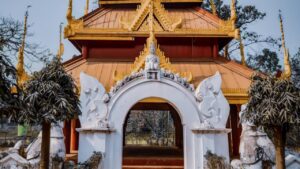
Disclaimer: Some of the links provided in the article may contain affiliate links. This means when you book or buy something using these links, you help support the website at no extra cost.

